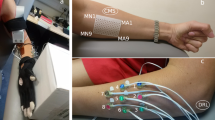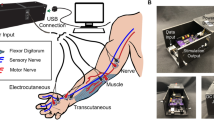Summary
-
1.
A mobile instrument for exploring and recording the topographic distribution of ESR on the human trunk has been described. Explorations are rapid and the record is immediately available.
-
2.
Topographic relations between the exploring electrode and a movable direct recording galvanometer are established by a pantograph linkage.
-
3.
Variations in current flow at a fixed voltage (“resistance”) along a strip of skin are recorded on stationary chart paper by variations in the oscillation amplitude of the moving, recording galvanometer. The ESR patterns of large areas are recorded by exploring a series of parallel strips of skin.
-
4.
The apparatus is adaptable for recording the topographic distribution of cutaneous features other than ESR.
-
5.
Sources of error are identified and their minimization or corrections are described.
Zusammenfassung
-
1.
Ein bewegliches Instrument zur Feststellung und Registrierung der topographischen Verteilung des elektrischen Hautwiderstandes am menschlichen Körper wurde beschrieben. Die Untersuchungen gehen rasch vor sich und die Aufschreibung steht unmittelbar zur Verfügung.
-
2.
Topographische Beziehungen zwischen der untersuchenden Elektrode und einem beweglichen, direkt anzeigenden Galvanometer sind durch ein Allschreiberglied hergestellt.
-
3.
Veränderungen im Stromfluß bei einer fixierten Spannung (Widerstand) entlang eines Hautstreifens werden auf einem fixen linierten Papier durch Änderungen der Schwingungsaplitude des beweglich registrierenden Galvanometers angezeigt. Die ESR-Muster eines großen Gebietes werden durch Untersuchungen einer Serie von parallelen Hautstreifen erhoben.
-
4.
Der Apparat ist für die Untersuchung der topographischen Verteilung auch anderer Hautverhältnisse als des ESR herzurichten.
-
5.
Irrtumsquellen werden angegeben und ihre Herabminderung bzw. Verbesserung beschrieben.
Résumé
-
1.
Un instrument mobile pour registrer la distribution topographique de la résistance dermique sur le corps est décrit. Les explorations se font vite et sont disponibles immédiatement.
-
2.
Des réactions topographiques entre l'électrode active et le galvanomètre mobile, registrant directement, sont executées par un membre pantographique.
-
3.
Les variations du courant électrique avec un voltage fixe le long d'une lame dermique sont registrées sur un papier réglé par variations des amplitudes des oscillations du galvanomètre à registration mobile. Les modèles de la résistance de la peau d'une vaste région sont marqués par examen d'une série des lames parallèles dermique.
-
4.
L'appareil est préparé pour l'examen de la distribution topographique de la résistance de la peau et pour d'autres méthodes.
-
5.
Les sources d'erreur sont identifiées et leurs restriction ou correction sont décrites.
Similar content being viewed by others
References
Katsuki, S., andK. Wake, Clinical studies on the viscero-cutaneous reflex. Kumamoto Med. J.6 (1954), 97–107.
Korr, I. M., Skin resistance patterns associated with visceral disease. Fed. Proc.8 (1949), 87.
Korr, I. M., Experimental alterations in segmental sympathetic (sweat gland) activity through myofascial and postural disturbances. Fed. Proc.8 (1949), 88.
Korr, I. M., P. E. Thomas andH. M. Wright, Patterns of electrical skin resistance in man. (Submitted herewith to Acta neuroveget., Wien.)
Ratcliffe, A. Hall andR. P. Jepson, Skin resistance changes in the lower limb after lumbar ganglionectomy. J. Neurosurg., Springfield,7 (1950), 97–105.
Richter, C. P., andBettye G. Woodruff, Changes produced by sympathectomy in the electrical resistance of the skin. Surgery10 (1941), 957–970.
Richter, C. P., Instructions for using the cutaneous resistance recorder or “Dermometer” on peripheral nerve injuries, sympathectomies and paravertebral blocks. J. Neurosurg., Spingfield,3 (1946), 181–191.
Thomas, P. E., andI. M. Korr, The automatic recording of electrical skin resistance patterns on the human trunk. EEG Clin. Neurophysiol.3 (1951), 361–368.
Thomas, P. E., andI. M. Korr, Significance of areas of low ESR. Fed. Proc.11 (1952), 162.
Thomas, P. E., andI. M. Korr, The relationship between sweat gland activity and the electrical resistance of the skin. (In press: J. Appl. Physiol., Wash.,10 (1951), 305–310.
Thomas, P. E., M. Wright andC. W. Hart, jr., Relation of sweat gland recruitment to ESR. Fed. Proc.12 (1953), 143.
Van Metre, T. E., jr., Low electrical skin resistance in the region of pain in painful acute sinusitus. Bull. Johns Hopkins Hosp.85 (1949), 409–415.
Author information
Authors and Affiliations
Additional information
With 5 Figures
These investigations were supported in part by grants from the National Institutes of Health, Public Health Service (B-29 and H-1632), and from the American Osteopathic Association, and by a contract (Nonr 243[00]) with the Office of Naval Research.
Rights and permissions
About this article
Cite this article
Thomas, P.E., Korr, I.M. & Wright, H.M. A mobile instrument for recording electrical skin resistance patterns of the human trunk. Acta Neurovegetativa 17, 97–106 (1958). https://doi.org/10.1007/BF01234167
Issue Date:
DOI: https://doi.org/10.1007/BF01234167




